Have you ever heard of keyword genealogy?
Ya know, like the study of families and the tracing of their lineage, but for keywords not humans?
Me neither.
So we’re going to invent it. #keywordgeneology
Because good keyword research is like the 23andMe of SEO (minus the maternal haplogroup): one, big, extended family tree that maps generations of related keywords with their ancestral keyword data.
And if people need genealogy, so do keywords, damnit.
In this article, we’re going to explore the step-by-step process we use to turn good keyword research into great keyword research for SEO by building keyword family trees.
That’s right: family trees complete with keyword progenitors, parents, children, grandkids, aunts, uncles, and cousins.
Let’s explore.
- What is SEO keyword research?
- Why is SEO keyword research important?
- How to do keyword research for SEO
- 1. Align SEO keyword research with marketing goals
- 2. Identify your seed keywords
- 3. Use keyword tools to discover long-tail keywords
- 4. Analyze and choose keywords
- 5. Build a family of semantic keywords
- Wrapping up
Get brand new SEO strategies straight to your inbox every week. 23,739 people already are!Sign Me Up
What is SEO keyword research?
By now, you’ve likely heard of “keywords.” But if not, here's a refresher:
Keywords are the search terms (strings of words) that people type into search engines like Google to find information online.
(We wrote an entire article on keywords if you’d like to learn more.)
Search engine optimization keyword research is the process of finding and analyzing keywords that people use to investigate the products or services you offer so you can rank for them on search engines.
Through keyword research, you can uncover:
- Keyword search volume
- Keyword difficulty (rankability)
- Search intent
- Content requirements
- Strategic opportunities
And so much more.
Why is SEO keyword research important?
Search engines like Google use keywords to determine how relevant your content is to a specific query.
If Google feels like the family of keywords on your page match the keywords associated with someone’s query, and that those keywords coalesce to fulfill the visitor’s expectations, they’ll rank your website higher.
If they don’t, you won’t rank at all.
Without keyword research, you’ll lack the data needed to find and prioritize relevant keywords strategically. And you won’t reach your ranking potential because of it.
For example, you may pursue keywords with no search volume; you may chase keywords that will never rank; or you may produce a listicle when the keyword really called for a tool.
How to do keyword research for SEO
Keyword research for SEO is an asynchronous process: there’s back and forth between steps, repeating steps more than once, and conducting steps at different times.
Not to mention everyone has their own process and preferences.
But no matter how you conduct your research, one thing remains the same: to do it well, you need organization and structure.
Which is why good keyword research is a lot like constructing a family tree.
Like a family tree, your keyword research should map the relationships between keywords, from short, broad topics at the top, to long, specific topics at the bottom.
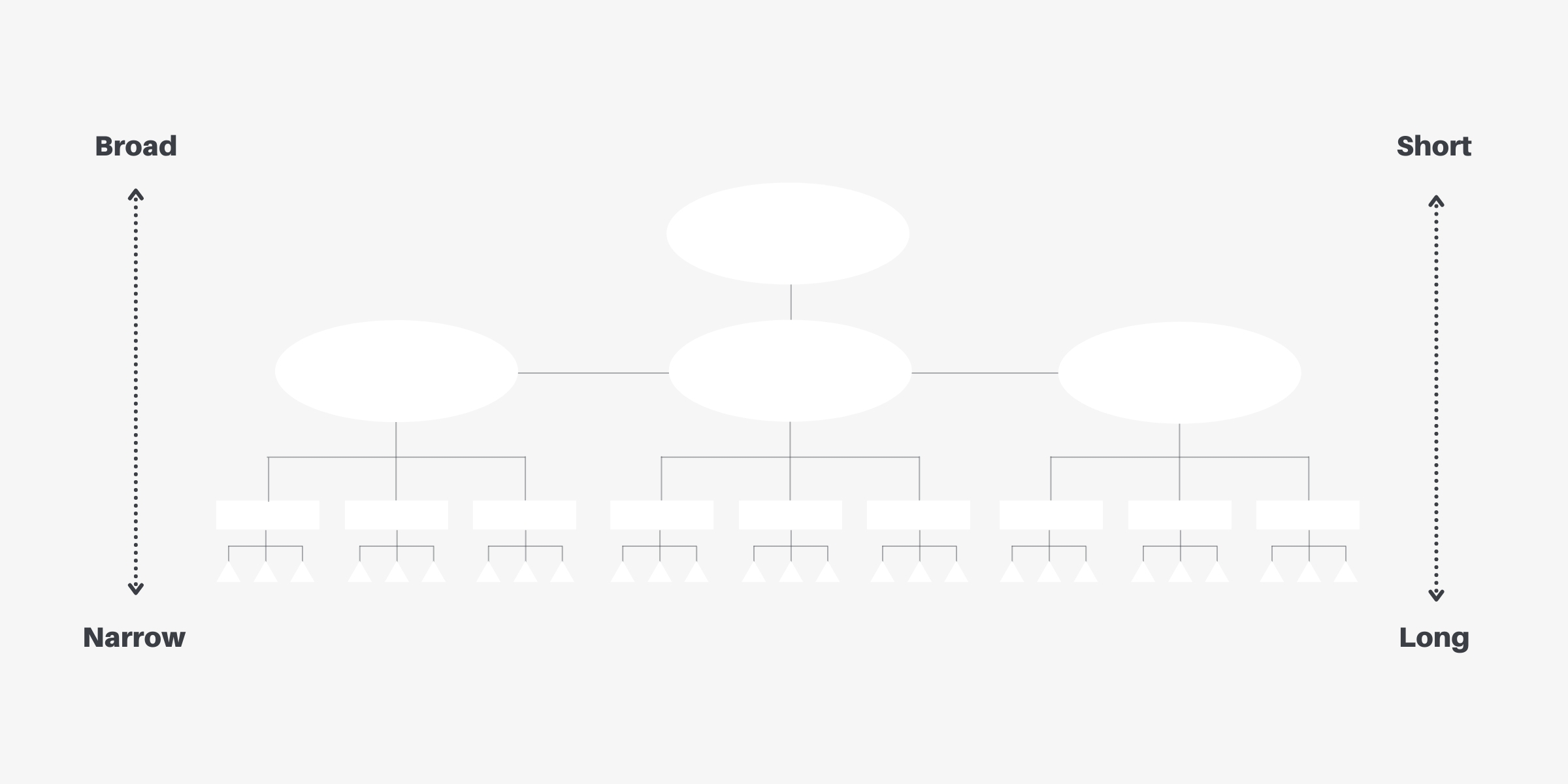
Key word (😉): relationships.
The goal of keyword research isn’t to find, analyze, and choose singular keywords to rank; it’s to find, analyze, and choose families of related keywords that can rank better together than by themselves. And in the process, deepen your website’s domain authority, not dilute it.
Here’s how we do it:
- Align keyword research with marketing goals
- Identify your broad seed keywords (parents and children)
- Use keyword tools to discover long-tail keywords (grandchildren)
- Assess and choose target keywords
- Group target keywords with semantic keywords (extended family)
Let’s explore.
1. Align SEO keyword research with marketing goals
Most keyword research articles skip this step altogether. But without clear objectives on who you want to attract and how those visitors will support your business, how are you supposed to pick keywords that lead to business results?
Marketing goals.
So before you make a list of keywords, first you need to think about SEO like a marketer.
How will you use search as a distribution channel to reach and influence your target audience?
Your answer will determine which keywords you do and don’t pursue.
We like to use two different mental models to complete this step: The 95:5 Rule (Cash Flow Funnel) or the Buyer Funnel.
95:5 Rule (Cash Flow Funnel)
What’s the 95:5 Rule? It’s a framework to remind marketers that the vast majority of people who engage with your marketing communications are not looking to buy at the moment.
In fact, 95% of buyers in any given market at any given moment aren’t interested in buying right now; they’re out-of-market, not searching for products or services you provide, but based on interests and behaviors are likely to enter the market in the future.
Whereas 5% of buyers are actively seeking products and services you offer; they’re looking to buy now.

This means that long-term growth is mostly about generating future cash flow by earning trust with out-of-market buyers (future buyers), and less about influencing immediate sales. Though both are important to growth.
When it comes to keyword research, which are you trying to accomplish?
Do you want to rank for keywords that will attract immediate prospects?
Or do you want to rank for keywords that will generate awareness, familiarity, and trust with future buyers who aren’t in-market yet but might be in the future?
For the latter, you’ll need to find the keywords your target audience uses before they enter the market.
What informational needs are they looking to fulfill that lead up to a purchase? How can you help them identify problems you solve and set them on the path toward investigating your products or services? (Hint: write content that helps your ideal customer solve the same problems as your products and services, but in different ways.)
For example: If you’re a skincare brand, keywords that target out-of-market buyers might include:
- “How to use retinol for the first time”
- “Difference between vitamin c and ferulic acid”
- “DIY night mask for acne”
To attract immediate prospects, you’ll need to find keywords with purchase intent. What search terms do immediate prospects use to investigate, compare, and shop for your products or services?
For example, sticking with our skincare brand:
- “Buy retinol .5%”
- “Drunk elephant vs. Paula’s choice vitamin C E ferulic”
- “MaeLove hyaluronic acid reviews”
Either way, in-market or out-of-market, brand building or sales activation, your keyword research and selection should reflect both.
Buyer funnel
Buyer funnel. Purchase funnel. Sales funnel. Marketing funnel. The Funnel. AIDA...
It’s all the same thing.
What’s the funnel? It’s a mental model (a metaphor) used to show how buyers move from one stage of their journey to the next until they purchase.
Forget for a second that buyers aren’t on a real journey, that they don’t take neat, linear steps to purchase, and that it’s impossible to create a universal process for buying what you sell.
Instead, use the funnel as it was intended: as a mental model.
When researching keywords, keep in mind the four (“metaphorical”) stages a buyer might find themselves in, along with the intent of each stage:
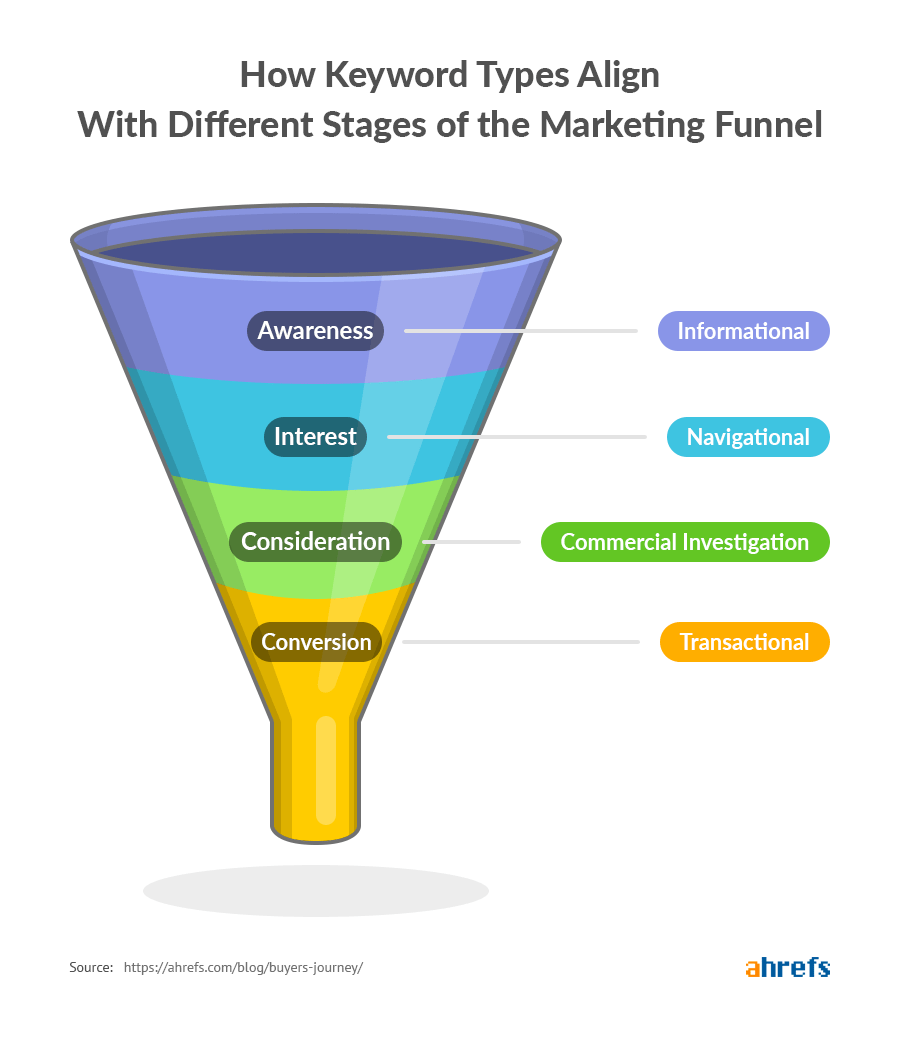
Informational intent
Do you want to grow awareness for your brand? You’ll need to satisfy the informational needs of your target audience before they start shopping (Think: the 95% in the 95:5 Rule).
Keyword example: “How to setup Google Ads”
Navigational intent
Do you want to make it easier for potential customers to find you? You’ll need to increase your branded search rankings (i.e. keywords with your name in them).
Keyword example: “KlientBoost single keyword ad groups”
Commercial intent
Do you want to attract people who are considering a purchase in the future? You’ll need to rank for keywords with commercial intent (i.e. search terms that indicate someone is considering buying), like comparisons, case studies, pricing, reviews, or service + location (“plastic surgeon Denver”).
Keyword example: “PPC agency vs. in-house”
Transactional intent
Or do you want to attract people who are looking to buy right now? You’ll need to rank for transactional keywords that include modifiers like “buy now,” “purchase,” “download,” “near me,” “demo.”
For example: “PPC agency Orange County”
Bottom line
It doesn’t matter which mental model you use to organize your keyword research as long as you start the process by thinking like a marketer, not a tactical buffoon. Most importantly, this step should always come first.
With clear objectives about the audience you want to attract and what business goals they’ll help support, now you can start compiling your keyword list.
2. Identify your seed keywords
Seed keywords (“short-tail” keywords or “head” keywords) are broad search terms (1-2 words) with high search volume and high competition. They’re the foundation of quality keyword research.
For example, a seed keyword for an automotive repair shop might include “auto repair.” Whereas a long-tail keyword (3+ words) might include “Mercedes auto repair in Huntington Beach” (more on long-tails in a minute).
Unlike “Mercedes auto repair Huntington Beach,” the keyword “auto repair” has broad, universal appeal, and therefore more search volume and competition.
Why are seed keywords important?
Seed keywords represent the primary topic(s) your website or articles will be about.
They’re the big, broad parents at the top of your keyword family tree. And they inspire your entire keyword strategy.
Since most seed keywords have too much competition, you’ll use them as a starting point to find related keywords that are less competitive and more rankable.
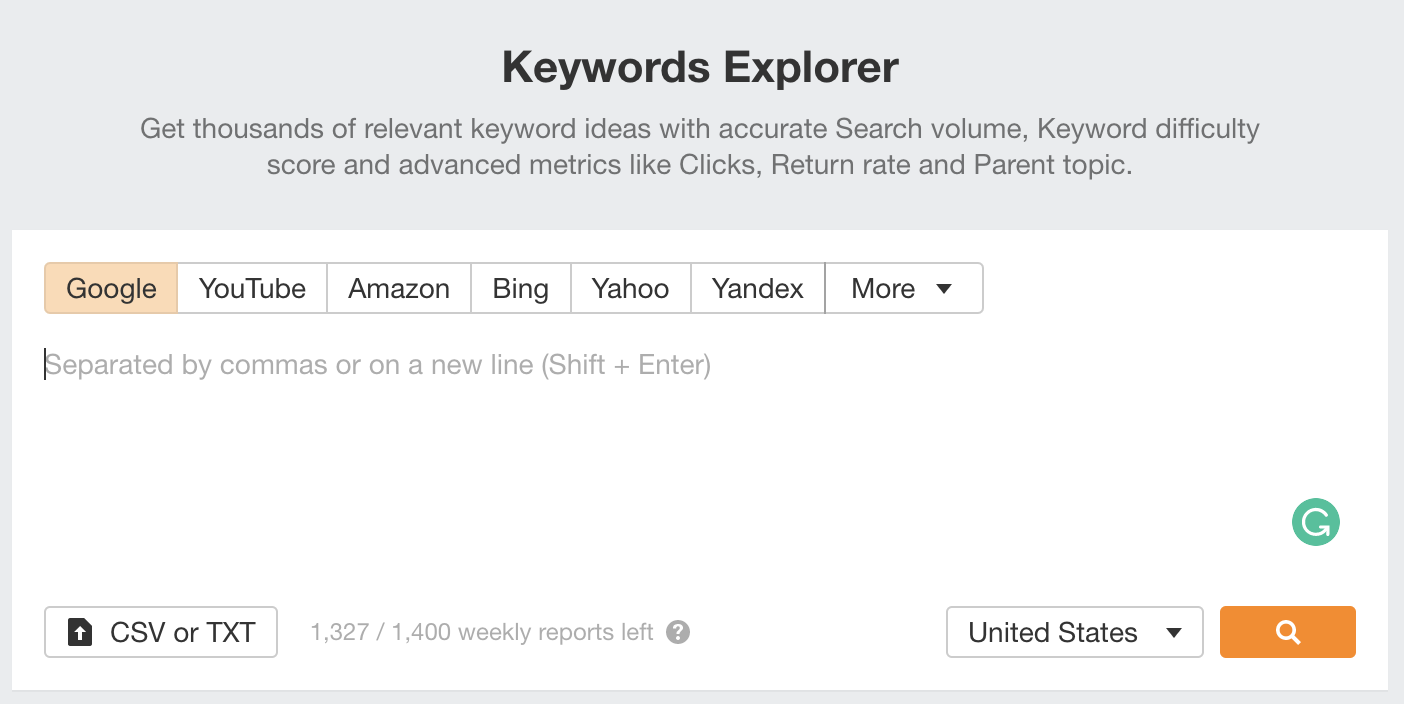
How do I use seed keywords?
By definition, seed keywords are short, broad, and most relevant to your business. But broad is a massive spectrum. You can drill down to subtopics of subtopics and still find broad keywords with high search volume, which is why we like to group seed words into three categories: domain-level, page-level, and content-level.
Domain-level seed keywords (proginators)
First, you’ll need to generate a shortlist of broad topics around which you want to build domain authority. These seed keywords will represent your website’s primary subject-matter expertise. For example, we sell digital marketing services like PPC, SEO, and email marketing, all of which are domain-level seed words. Even if we don’t rank for these terms outright, every keyword ranking we pursue will stem from here, which is why we call them “progenitor topics.”
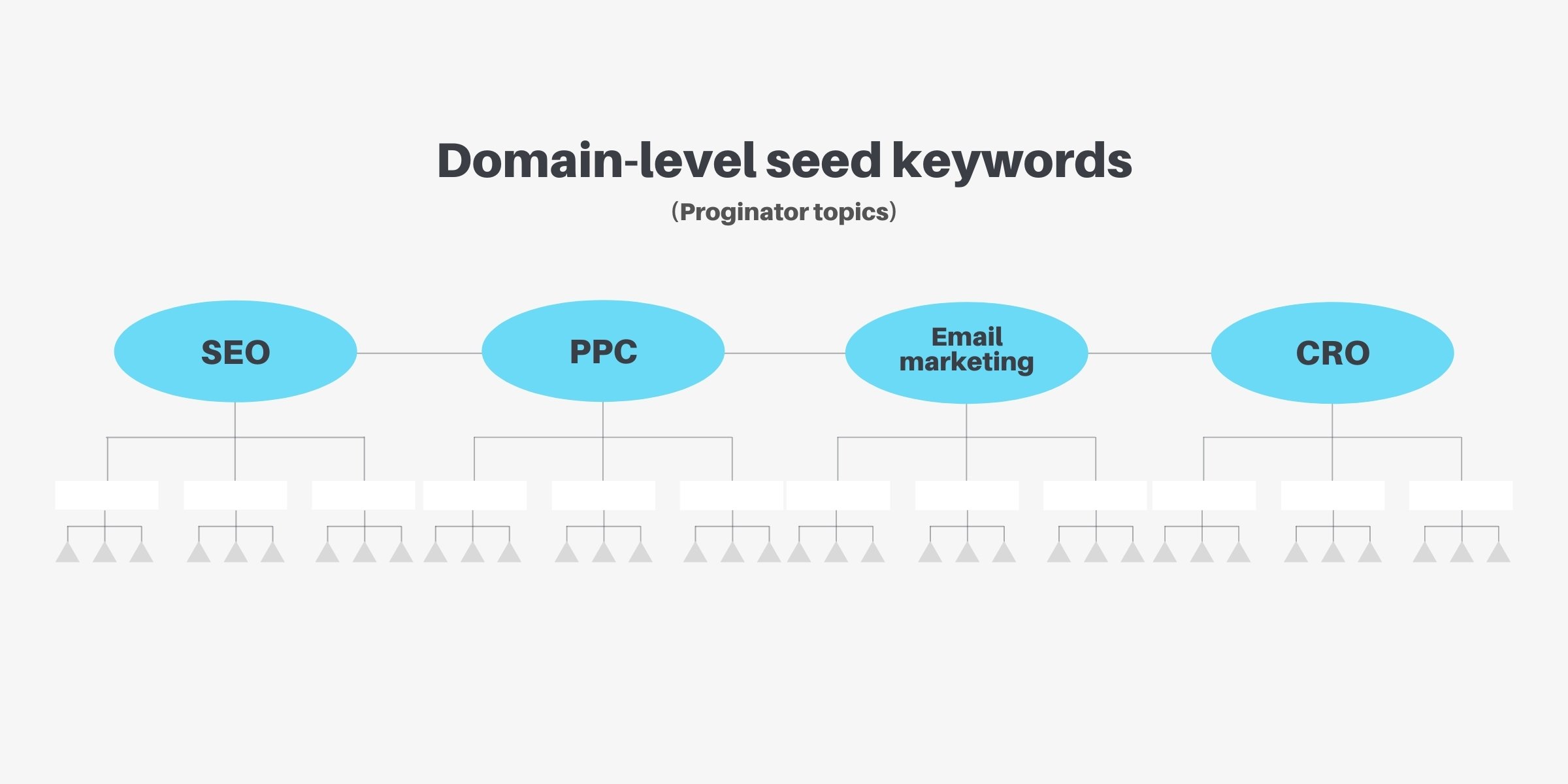
Page-level seed keywords (parents)
Second, after defining your domain-level seed keywords, you’ll use them to unearth subtopics for which you can rank certain articles or web pages. Subtopics can include more specific seed keywords, but they’re still quite broad. Either way, these seed keywords are the direct descendants of your domain-level keywords.
For example, if “SEO” is one of our domain-level keywords, then “on-page SEO,” “off-page SEO,” keyword research, and “technical SEO” are genealogical subtopics we also want to rank.
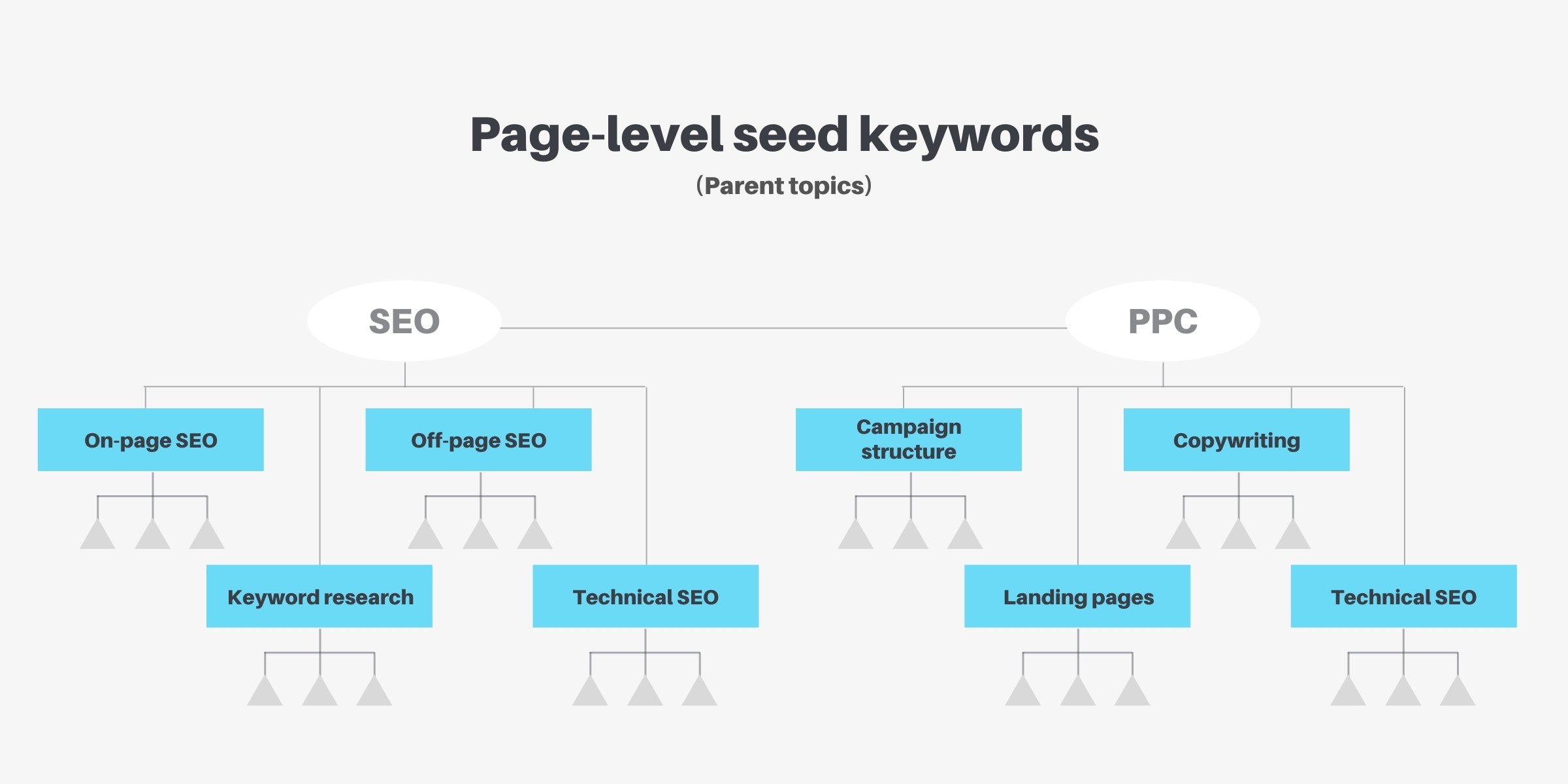
Content-level seed keywords (children)
Last, it’s time to finish your nuclear family. Content-level seed keywords are the children of page-level seeds: slightly more specific, but still broad enough to rank as their own page if needed.
For example, if “off-page SEO” is one of our page-level keywords (which descended from our domain-level keyword, “SEO”), then “link building,” “citations,” “reviews,” “brand mentions,” “linkable assets,” “guest posting,” “and local listings” are genealogical subtopics we also want to rank.
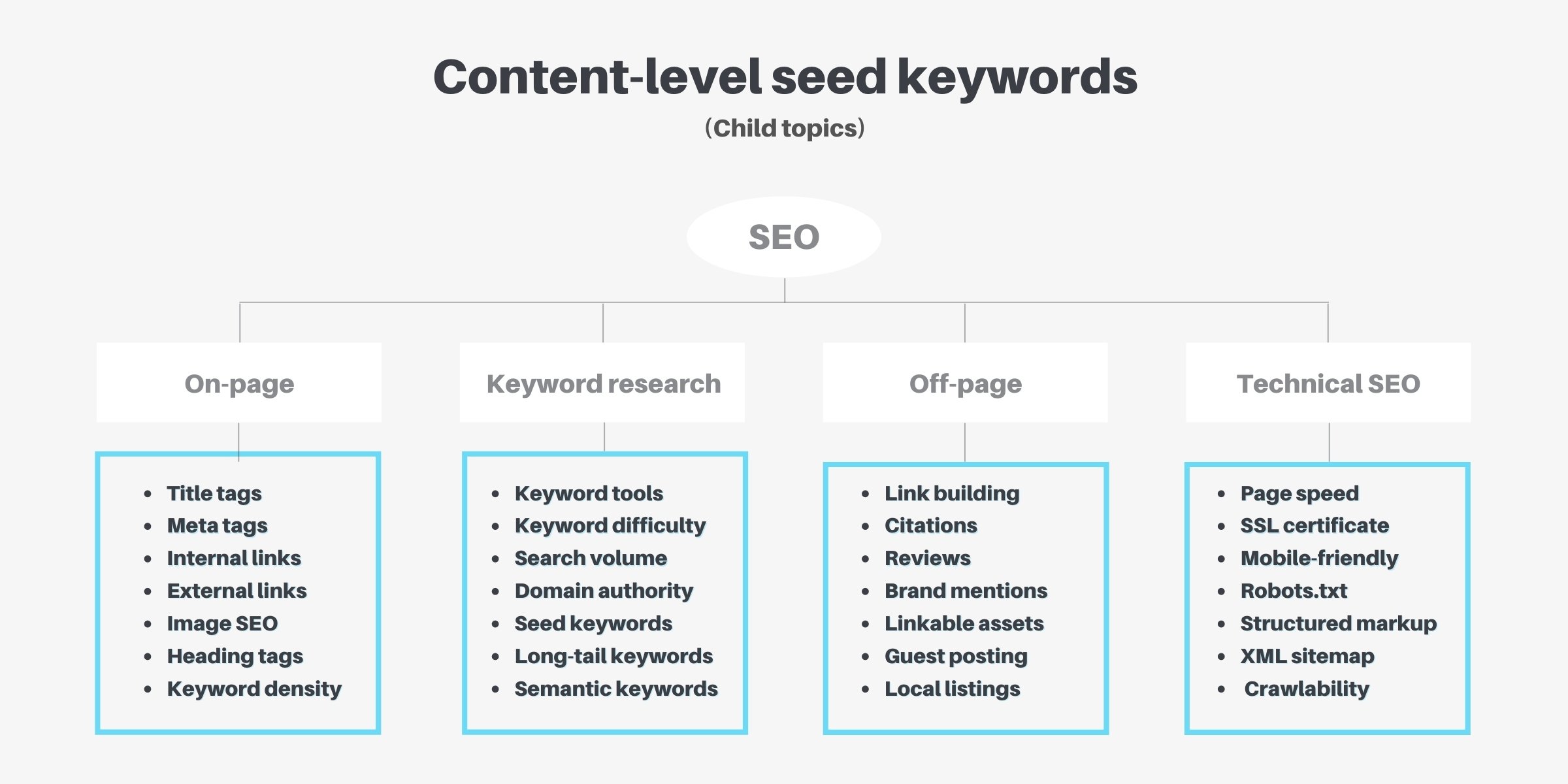
How do you find seed keywords?
Since all three levels of seed keywords are still broad, all you need is a healthy dose of product knowledge and/or subject-matter expertise to drill down this far.
Product and service categories
Every seed list should start with the names of the product/service categories you sell. If you sell chocolate, then chocolate is a domain-level seed word. Then go one step deeper: what types of chocolate do you sell? And so on.
Subject-matter expertise
What topical categories do you explore on your blog? These topics typically relate to what you sell. But if you don’t sell anything, what broad categories do you discuss on your blog?
Tangential topics
Think of parent topics that may not directly explore parts of your products or services, but do explore related topics your customers also find interest in. For example, Andy Crestodina of Orbit Media routinely talks about content marketing on his blog but his business specializes in website design and development. Or Buffer talks about workplace culture, even though they sell social media software.
Competitors
Using a keyword tool like Ahrefs or SEMRush, you can easily input your competitors’ domains and find out which seed keywords they already rank for organically. Find them. Analyze them. Take them. 👿

Existing rankings
There’s no use in creating a new page (and potentially cannibalizing your search results) if you already have a page that ranks high for a specific keyword.
So before you queue up hundreds of keyword ideas, check to see what seed keywords your website already ranks for, and use this list as a baseline for your keyword research.
If you don’t have a website yet, then this point is moot (obviously). Skip ahead.
If you do, open up your Google Search Console account, navigate to the Performance tab (to the left), click on the “search results” tab, check the “average position” checkbox, then scroll down to see what pages rank in what positions.
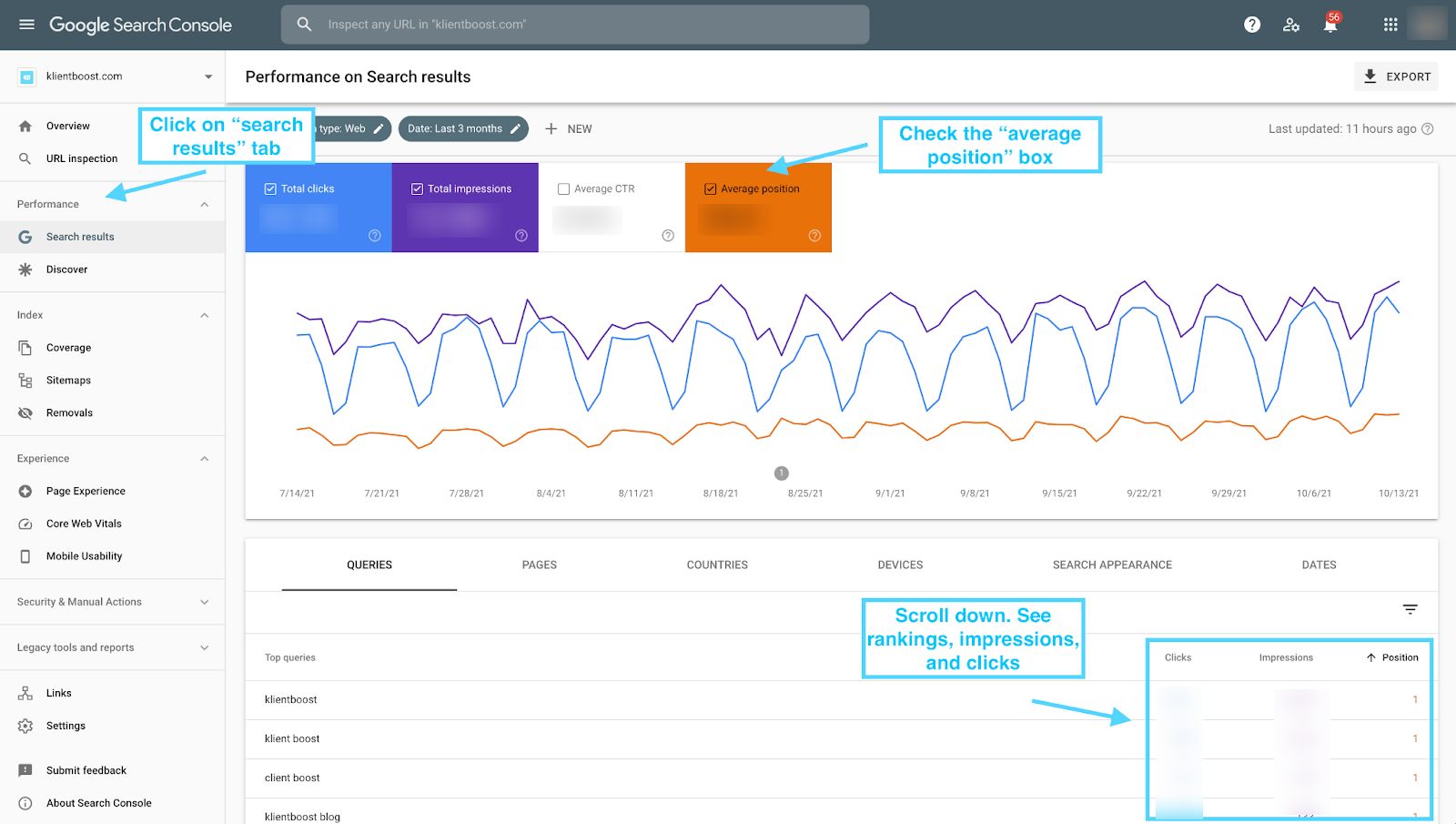
With your seed list built, now it’s time to finish your keyword genealogy: grandkids (AKA long-tail keywords).
3. Use keyword tools to discover long-tail keywords
Keyword tools are like an assortment pack of 4th of July fireworks: Tons of variety, all pretty much the same, a couple of big bangs, a few duds.
Lucky for you, we wrote an entire article on the 13 best keyword research tools for SEO (and why we love them).
But for now, let’s highlight our favorite SEO tools (in no particular order):
- SEMRush Keyword Magic
- Ahrefs Keyword Explorer
- MOZ Keyword Explorer
- Google (Trends, Keyword Planner, Search Console)
- Google SERPs (autocomplete, related searches, people also ask)
- Answer the Public
- Ubersuggest
- Soovle
- SpyFu
- Long-tail Pro
- Seed keywords
- Keyword Keg
- Keyword Everywhere
- Clearscope
- KWFinder
- KeywordTool.io
No matter which tool(s) you use during this phase of keyword research, the end goal is the same: to expand your list of seed keywords with more specific but related keywords.
Enter: Long-tail keywords.
Unlike short-tail seed keywords, long-tail keywords are longer, more specific search queries ranging from 3-8+ words.
Think of long-tail keywords like the grandkids to your content-level seed words: topically related to parents and children, but with less search volume, fewer competitors, and an easier chance to rank.
For example, if we open up the “Link building” child of our “Off-page SEO” parent in our keyword family tree, the long-tail keywords would look as follows:
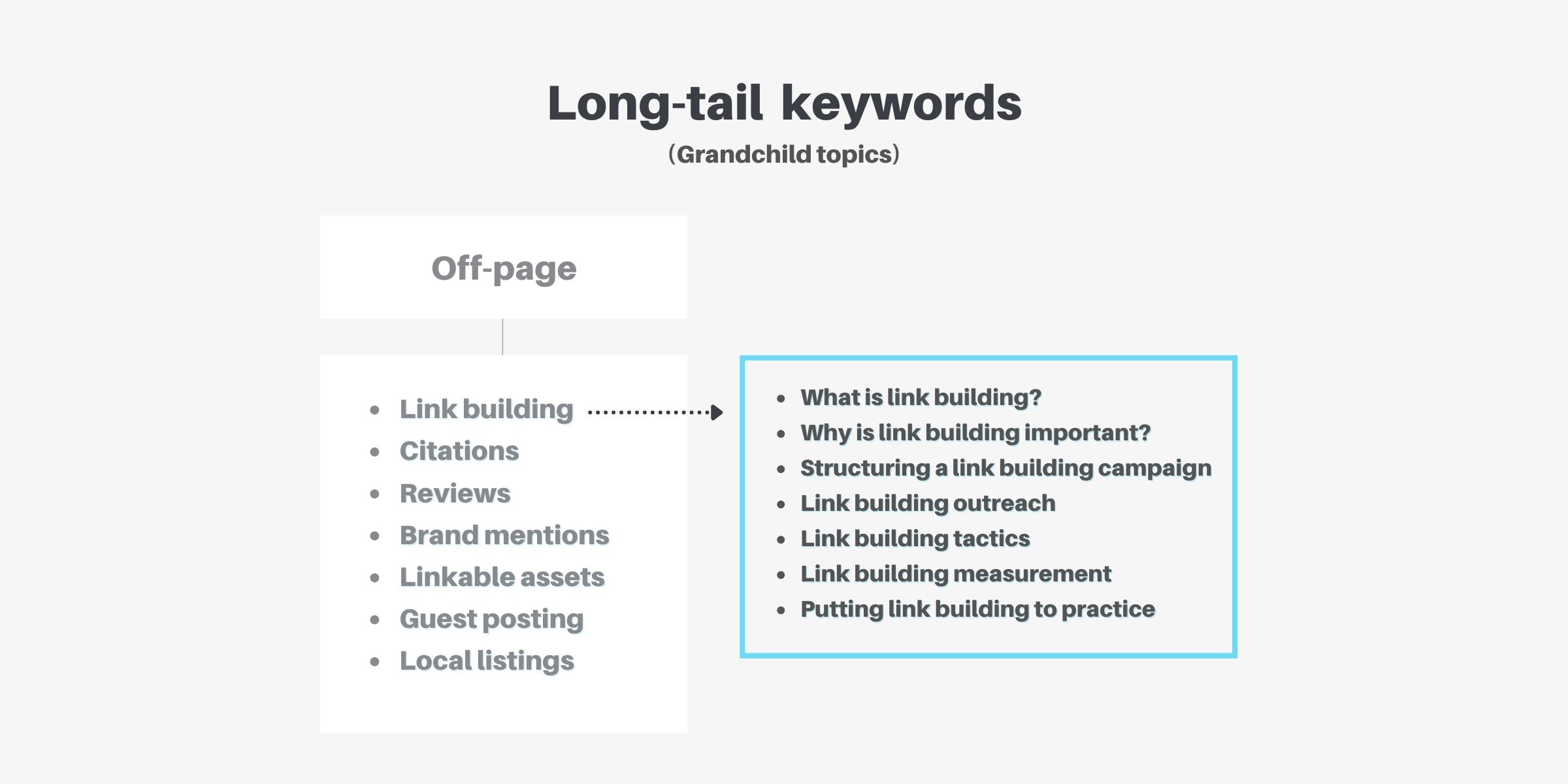
How do you use long-tail keywords?
Long-tail keywords are direct descendants of your content-level seed keywords. Depending on competitiveness and search volume (more on this in the next step), you’ll use them in one of two ways:
- Competitive long-tails: If a long-tail keyword has decent search volume and high competition (likely), it’s best to break it out into its own page (as if it’s a seed keyword). Then you would find a family of longer-tail keywords to support it within the text.
- Non-competitive long-tails: For long-tails with less search volume and competition, instead of breaking them out into their own respective pages (since search volume isn’t high enough), you can group them together within a single article that ranks for a broader seed keyword. For example, using the link building example above, the corresponding long-tail keywords would function as headings and subheadings within the article, not as their own pages.
How do you find long-tail keywords?
Lucky for you, we wrote an entire article on finding long-tail keywords: How to Find Long-tail Keywords for SEO.
But let’s review the basics here.
First, since you’ve already compiled your list of seed keywords, you can do it manually (for free) using Google’s search tools, forums like Reddit or Quora, free tools like Answer the Public, or by asking your frontline teammates like sales reps, customer support, and account managers for frequently asked questions related to your seed words.
For example, using just Google, you can type in your seed keyword, then look at the autocomplete suggestions, and find an entire list of long-tails:
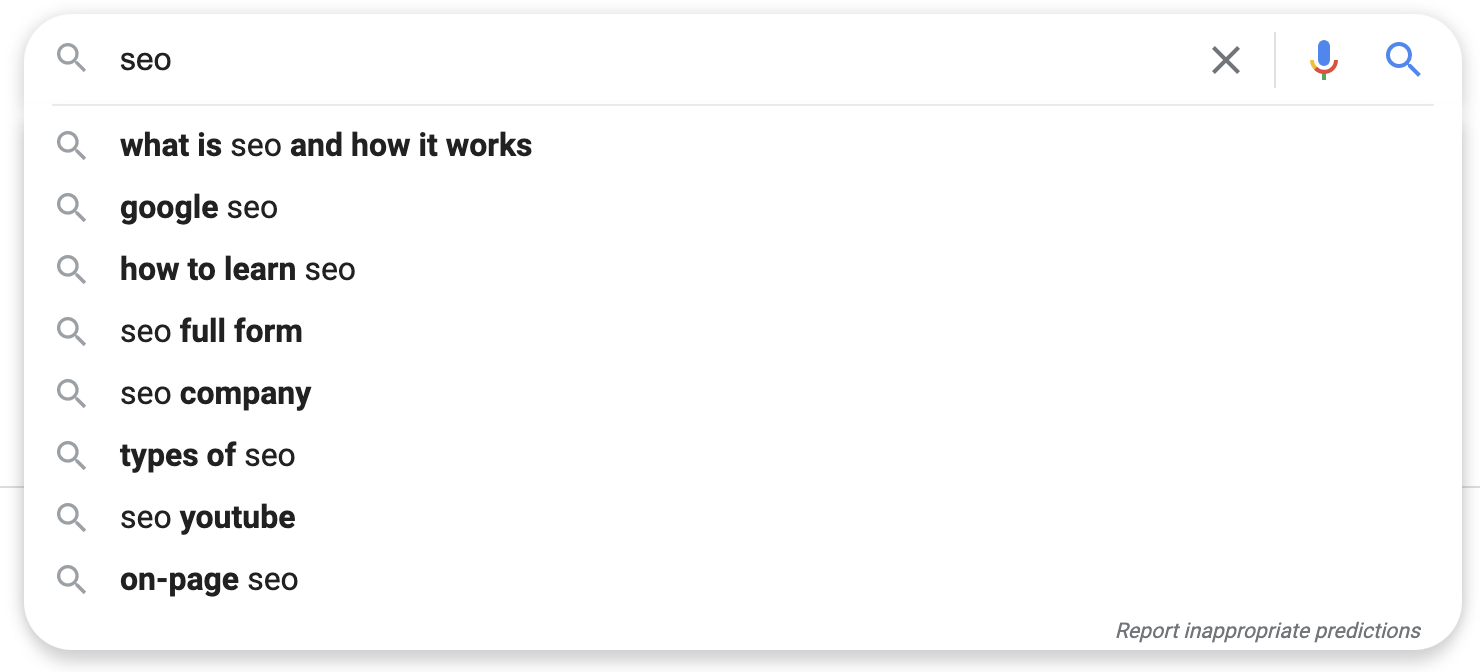
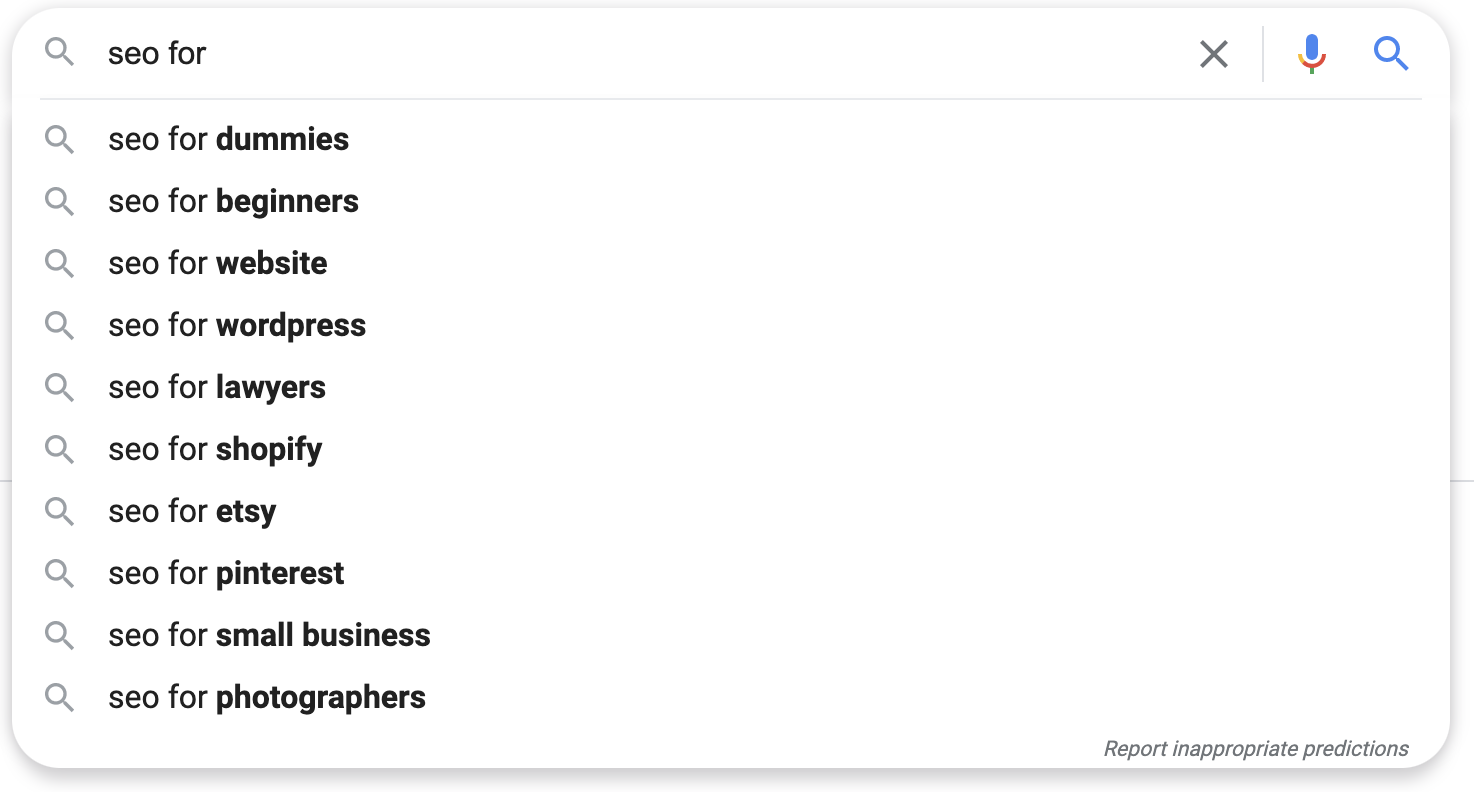
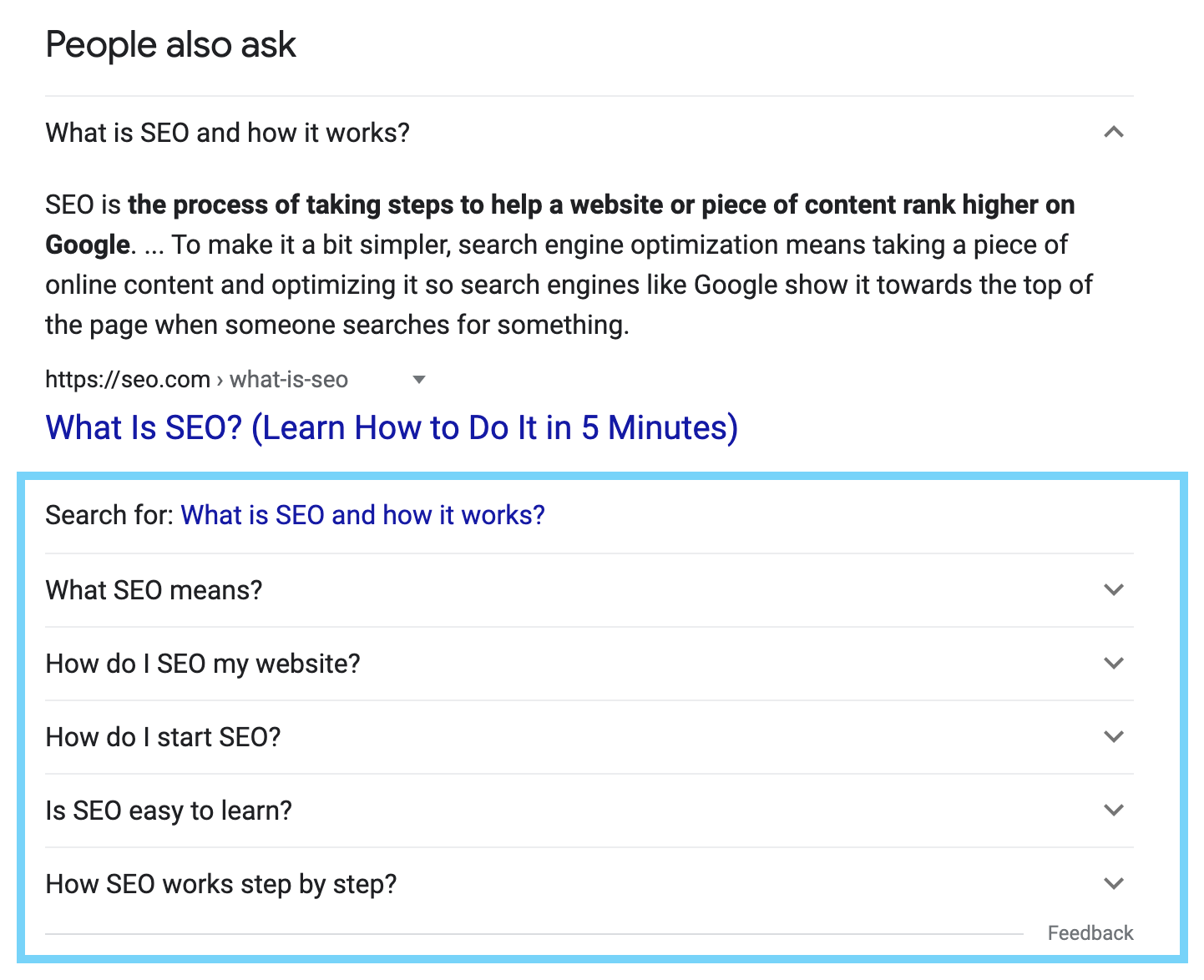
Or use “Related searches” at the bottom of SERPs (also long-tails):
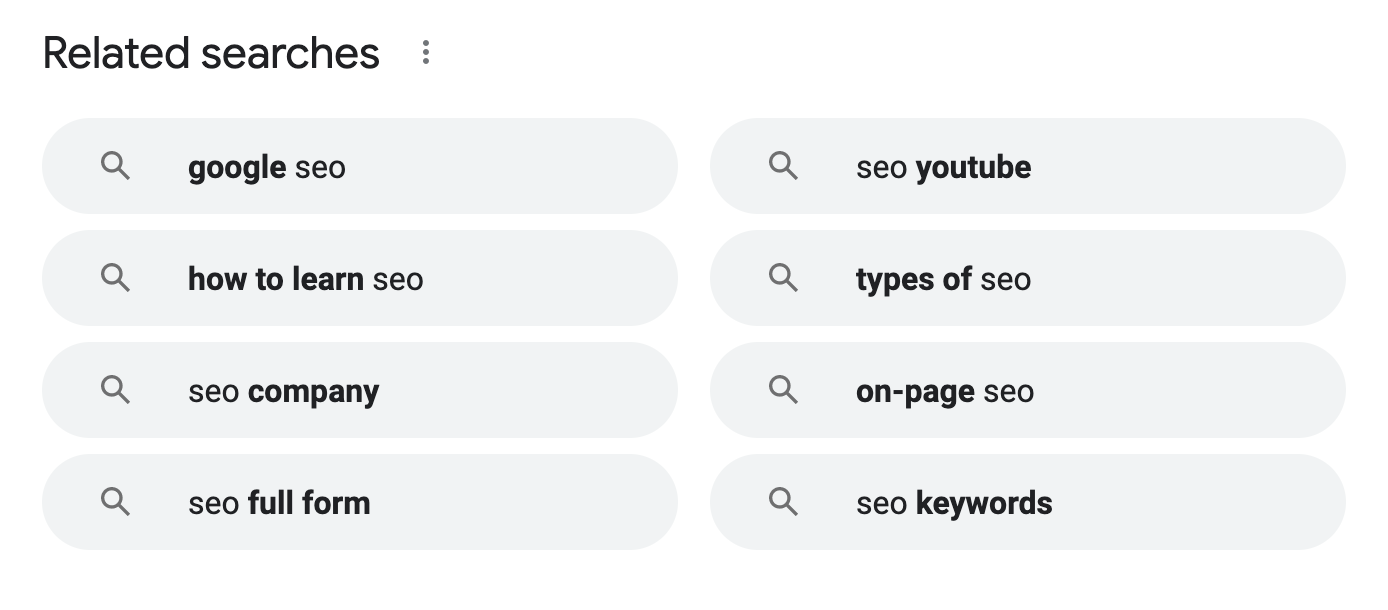
And second, to get more variety, along with supporting data like search volume and difficulty, you can use keyword tools to find long-tail keywords.
Simply enter one of your seed keywords into the tool and viola!
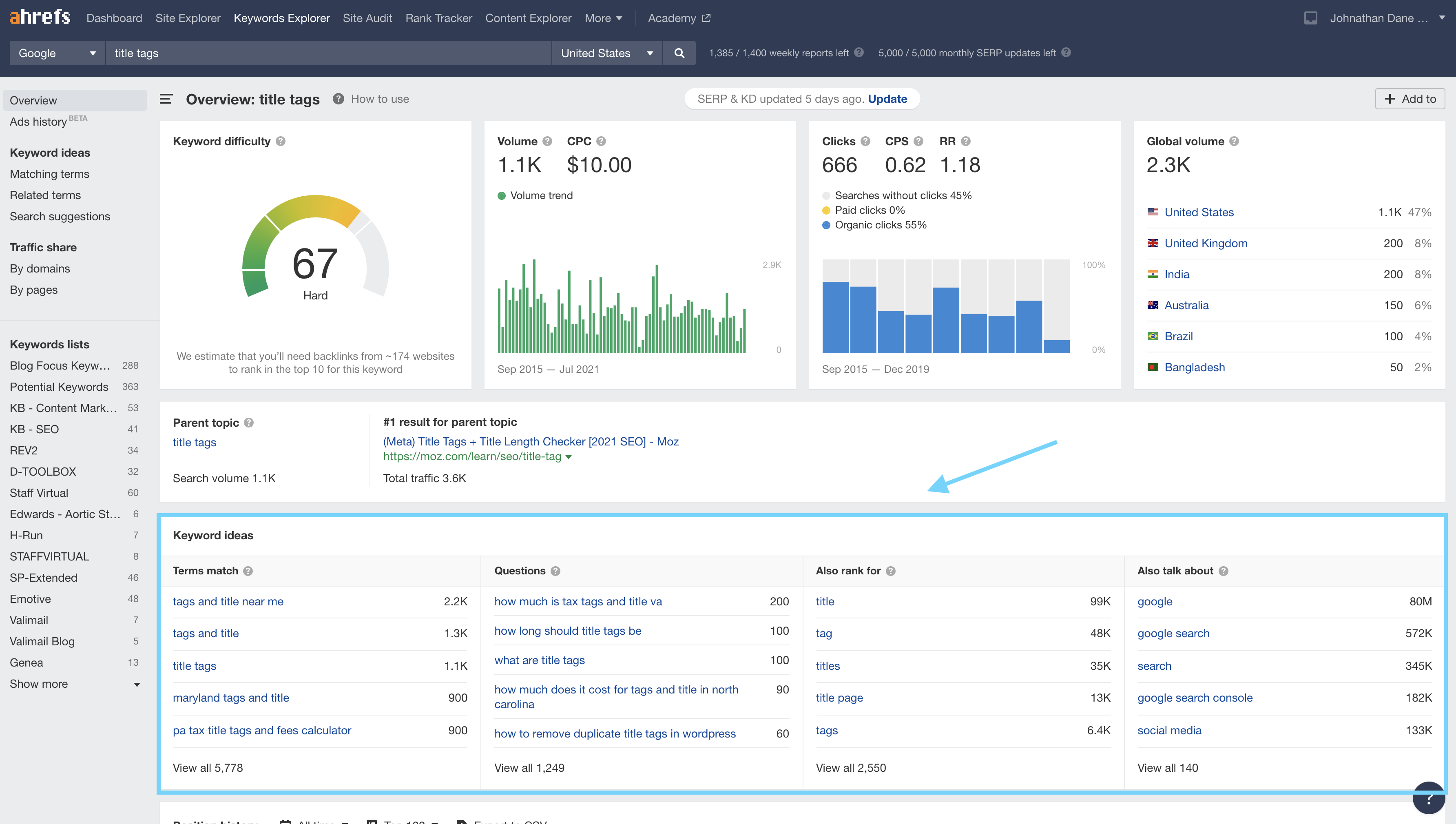
No matter which tool you use, free or paid, it helps to look for certain types of long-tail phrases people use most often.
Namely questions, prepositions, and comparisons.
Question-based keywords
Like it sounds, question-based queries refer to search terms that ask specific questions.
When someone searches for information on Google, they’re always looking for an answer, even if they don’t word their query as a question. Question-based keywords get straight to the point: they’re specific, so it’s easy to identify search intent (no guessing).
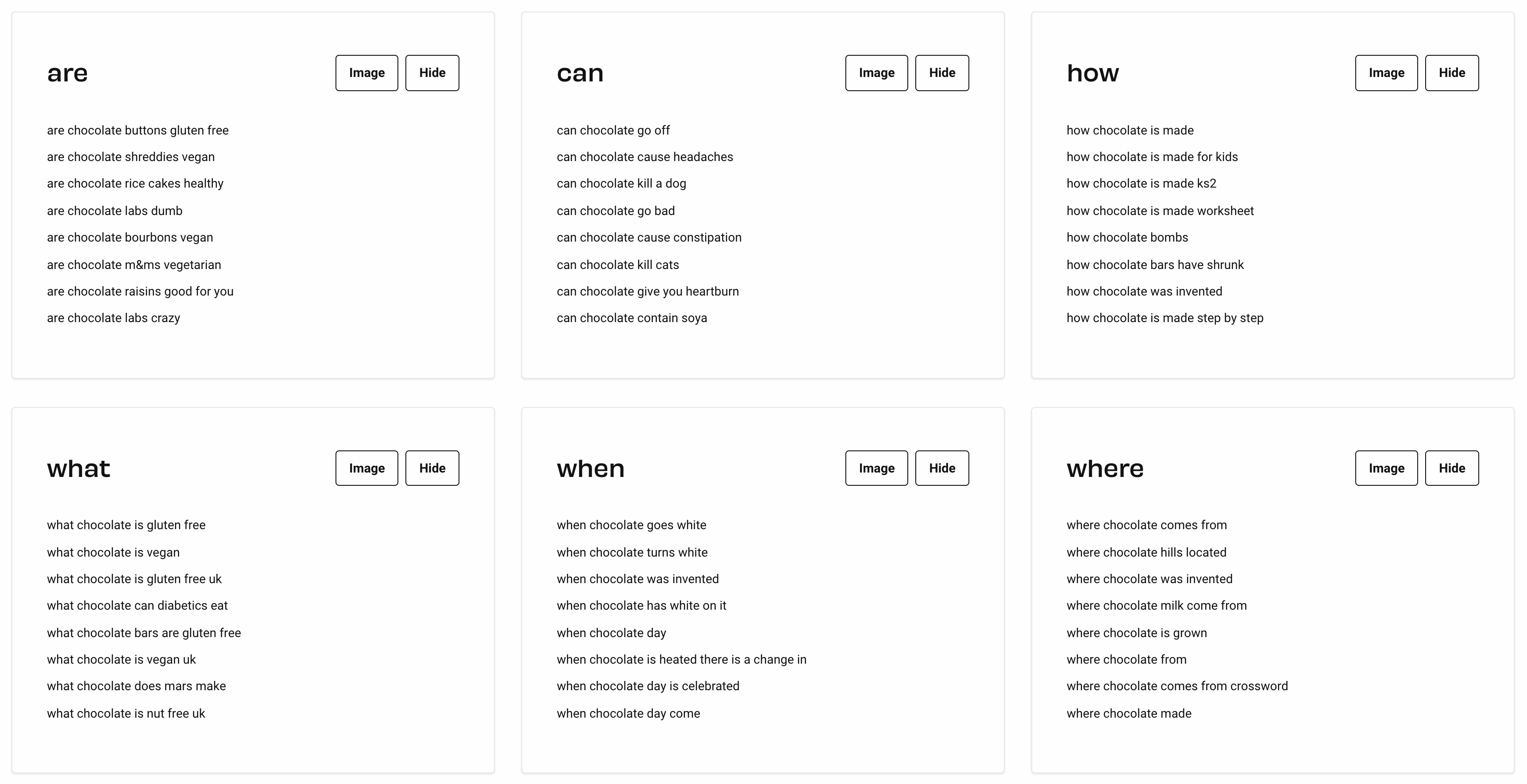
Prepositional keywords
Prepositional keywords refer to search queries with prepositions in them. For example, can, for, is, without, near, to, and with. Aside from questions, prepositional phrases are one of the most popular ways people search.
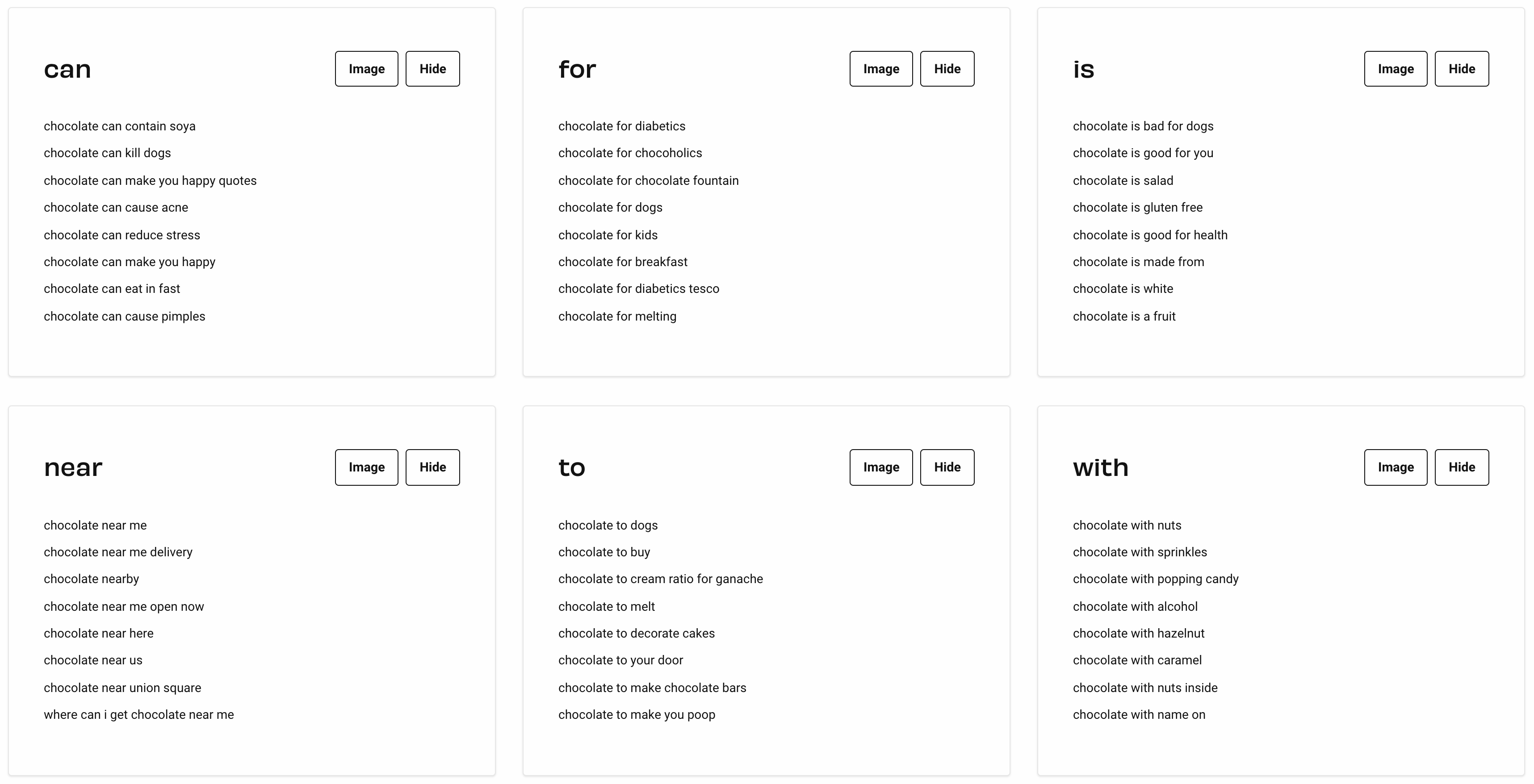
Comparison keywords
Comparison keywords refer to search phrases that use words like or, versus, and, or like. They’re great for uncovering commercial-intent keywords (i.e. high likelihood someone is looking to buy eventually) since comparison is a critical step before purchasing.
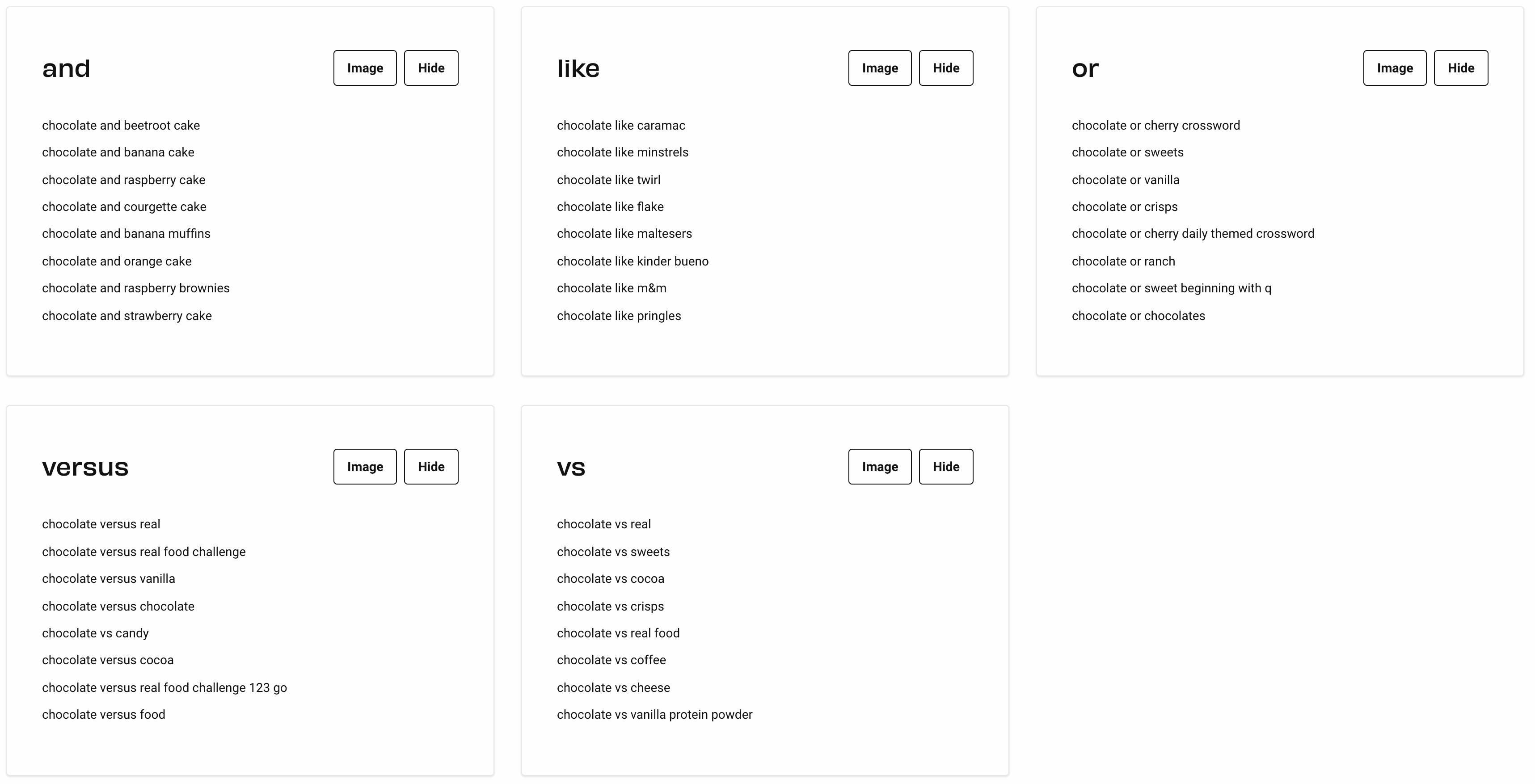
At this point in your research, you should have four layers of keywords (domain seeds, page seeds, content seeds, long-tails), all linked together in your keyword family tree.
All good, but it’s still just a list of keywords.
Now it’s time to put some data behind your keywords and choose the best ones to pursue.
4. Analyze and choose keywords
Making a list of potential keywords is easy. Choosing the right keywords to pursue isn’t.
Once you map out your keyword family tree, with seed keywords at the top to long-tail keywords at the bottom, how will you know which to pursue and prioritize, which need their own page, or which you should group together on one page?
Enter: keyword analysis.
Keyword analysis looks at factors like search volume, domain authority, keyword difficulty, and rankability to chart the path forward.
This is a massive topic, so we dedicated an entire article to it: How to Choose Keywords for SEO by Answering 7 Simple Questions.
But for now, let’s briefly explore the seven questions you need to answer for every keyword before moving forward:
Is there enough search volume to drive meaningful results?
Simple. Once ranked, will the keyword drive enough traffic over time? No use ranking for keywords that won't drive traffic, not unless they’ll drive sales.
Is it rankable? Or too difficult?
Keyword difficulty is a score (0-100) generated by keyword tools that uses quality and quantity of backlinks to estimate how difficult it will be to rank. The higher the score, the more backlinks needed, the harder to rank. Do you have the resources to acquire enough backlinks?
Do I have the domain authority needed to outrank opponents?
Domain authority (DA) is measured much like keyword difficulty (using backlinks) but at the domain level. It represents a website’s ability to rank. Higher DA is associated with higher rankings. Based on the DA of competing sites, is your DA high enough to compete? If not, no use trying.
Can I satisfy search intent?
What do visitors expect to find once they land on your website? Google knows. If you can’t deliver the content type, format, or depth people expect, or you can’t answer the question with the best version of the answer, then you won’t rank.
If I rank, who will get clicks: me or Google?
Always. Check. SERPs. Manually. Between featured snippets, content blocks, ads, carousels, map results, and personalized search results, it’s getting harder and harder to get clicks (Google keeps stealing them).
Will a keyword activate sales or build my brand?
Like we mentioned in step one, marketing needs both: to influence immediate sales (sales activation) and to influence future sales (brand building). Knowing which bucket a keyword falls into will help you choose keywords that support business goals, short-term and long-term.
If you’re asking yourself, “How do I identify keyword difficulty, search volume, domain authority, and search intent?” Not to worry—we cover it all in our “choosing keywords” article.
Bottom line: Keyword research without keyword analysis is like taking stabs in the dark.
Don’t do it.
Instead, enlist your favorite keyword research tool and collect the data from your answers above. Only then can you make a strategic choice about which new keywords to pursue.
if you haven’t already, now is a good time to bring your list into a CSV file (e.g. excel or Google Sheet). Add your keywords, organize them so you can visually see their topical relationships to one another, then add your analysis next to each keyword using the following eight columns:
- Monthly search volume
- Keyword difficulty score
- Content type
- Content length (average)
- Organic Search intent (informational, navigational, commercial, transactional, local)
- DA of ranking websites (average)
- # of SERP features
- Business goal (sales or brand)
Keywords. Relationships. Data. All the information you need to choose the right keywords and formulate your SEO strategy
One. Last. Step.
5. Build a family of semantic keywords
You found your parents (seed keywords). Your parents had children (narrower seed keywords). Your children married and had their own kids (long-tail keywords). And you’ve completed your keyword analysis and made a list of priorities.
Last step: Uncles, aunts, and cousins through marriage.
Enter: semantic keywords.
We'll keep this brief since we have an entire article breaking down Semantic SEO as well: What Is Semantic SEO And Why Does It Matter?
Semantic keywords are words and phrases that are topically and conceptually related to your main keyword. In other words, you would expect to find them within the same article as your target keyword.
Think of them like your keyword extended family: they’re the accompanying words you should include in your page content to maximize relevancy.
For example, if your target keyword is “SEO”, you would expect to find semantically-related keywords like “rankings,” “organic traffic,” “SERPs”, and “long-tail keywords” within the same article.
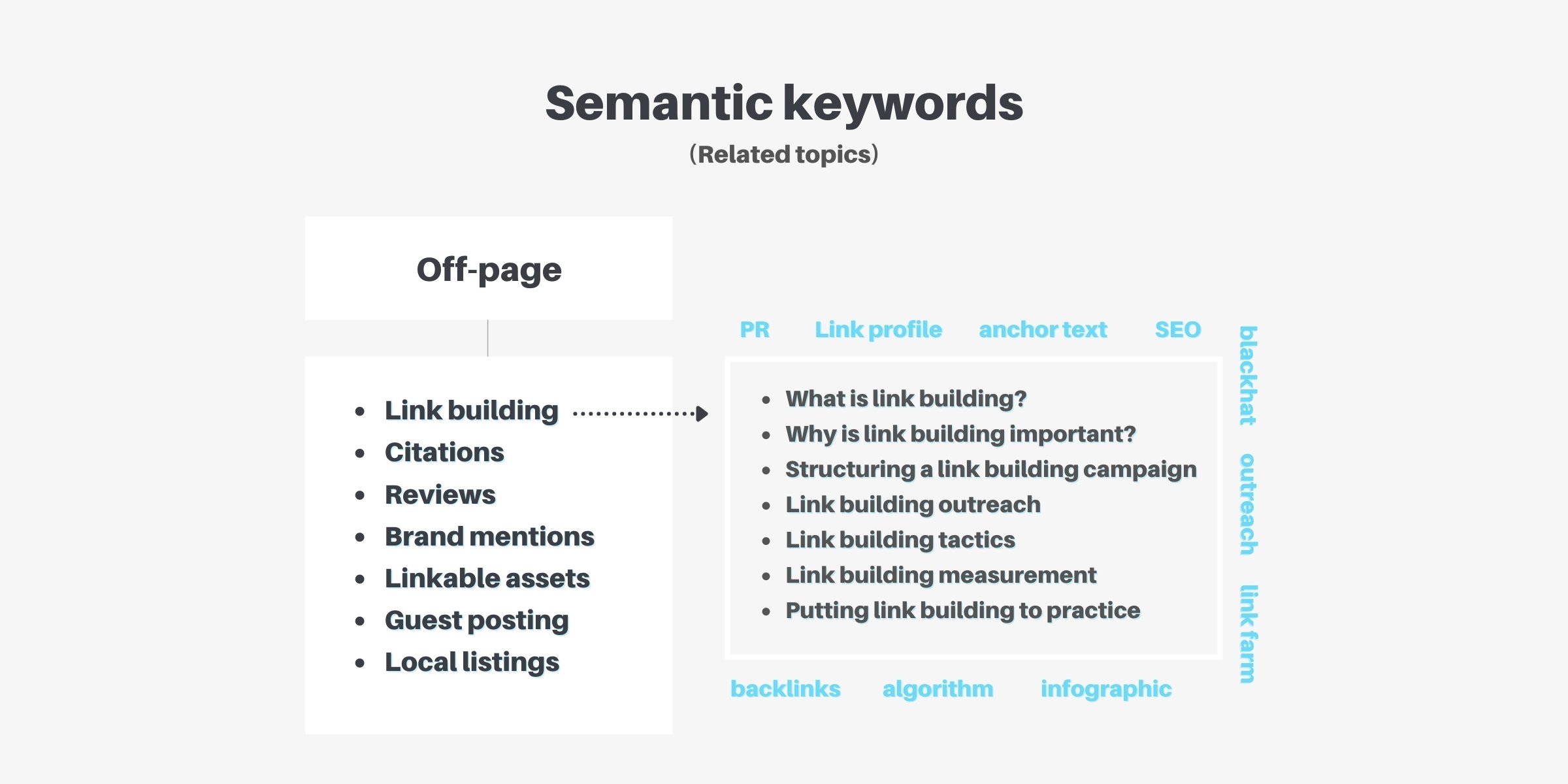
Why are semantic keywords important?
Relevance and meaning.
Google relies on synonyms and theme-related topics to understand the context and meaning of a web page.
They don’t just look at individual keywords as their own entities anymore; they analyze the relationships between words to understand a page like you or I would.
Semantic keywords are like ranking breadcrumbs: the more you include, the easier it is for Google to identify the meaning of your page, which ultimately leads to improved rankings.
How to find semantic keywords
First, you can find semantic keywords using the same Google SERP tools you used to find long-tail keywords: Autocomplete, Related searches, and People also asked.
Some of our other favorites include:
YouTube Suggest
Like Google autocomplete, YouTube also has a drop-down of related keywords (so does Amazon for those who sell products).

Google Trends
Type a keyword into Google Trends (free), and you can see the historical popularity of a keyword. Bonus: It also shows you closely related topics and queries at the bottom.
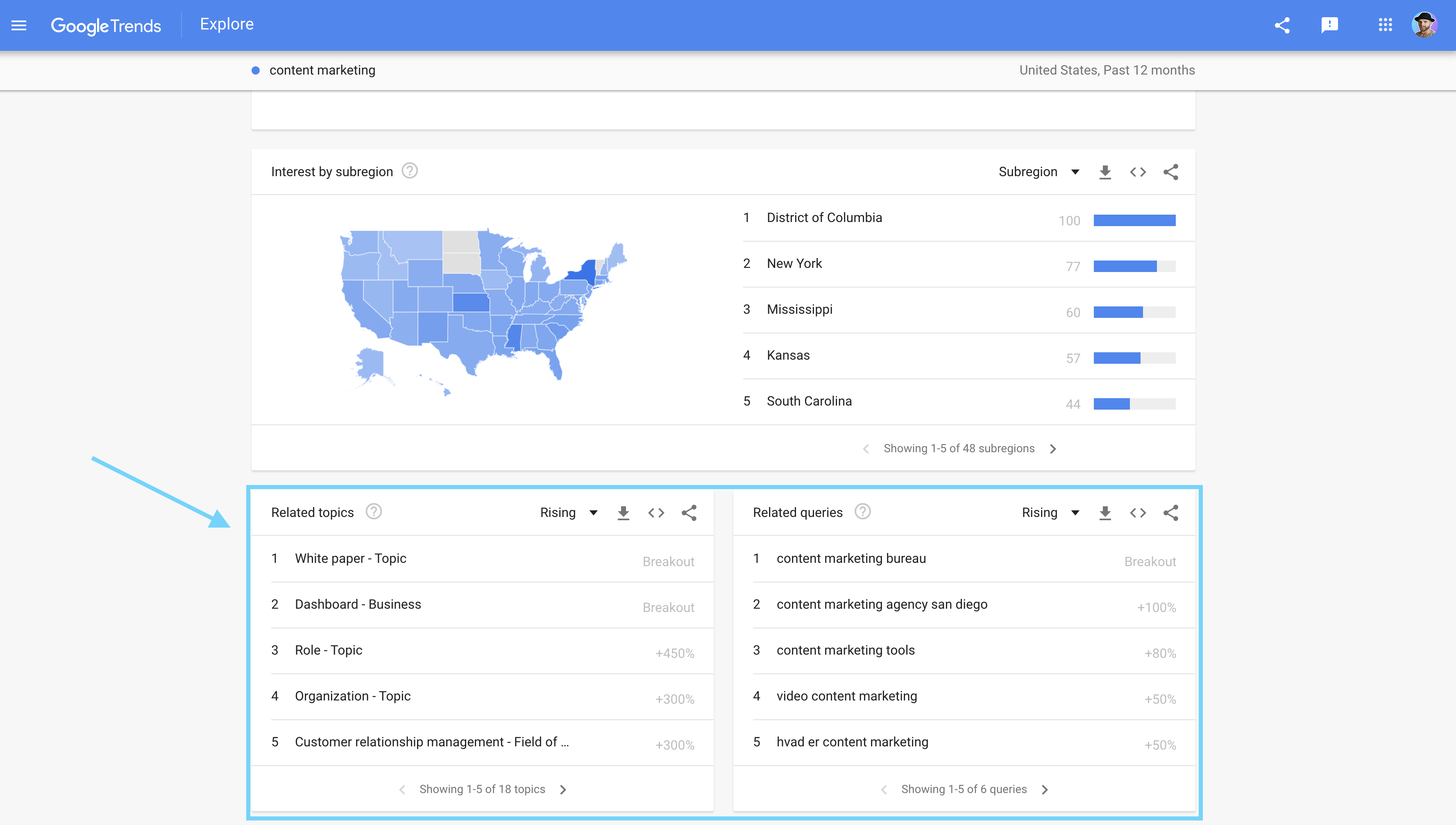
ClearScope.io
The best semantic keyword tool around (no joke). Tools like ClearScope extract a list of keywords that the top-ranking websites include in their content so you can easily see which related keywords they use to rank so high. Enter your target seed keyword in the editor, and they’ll tell you exactly what semantic keywords you should include to increase relevance. Brilliant.
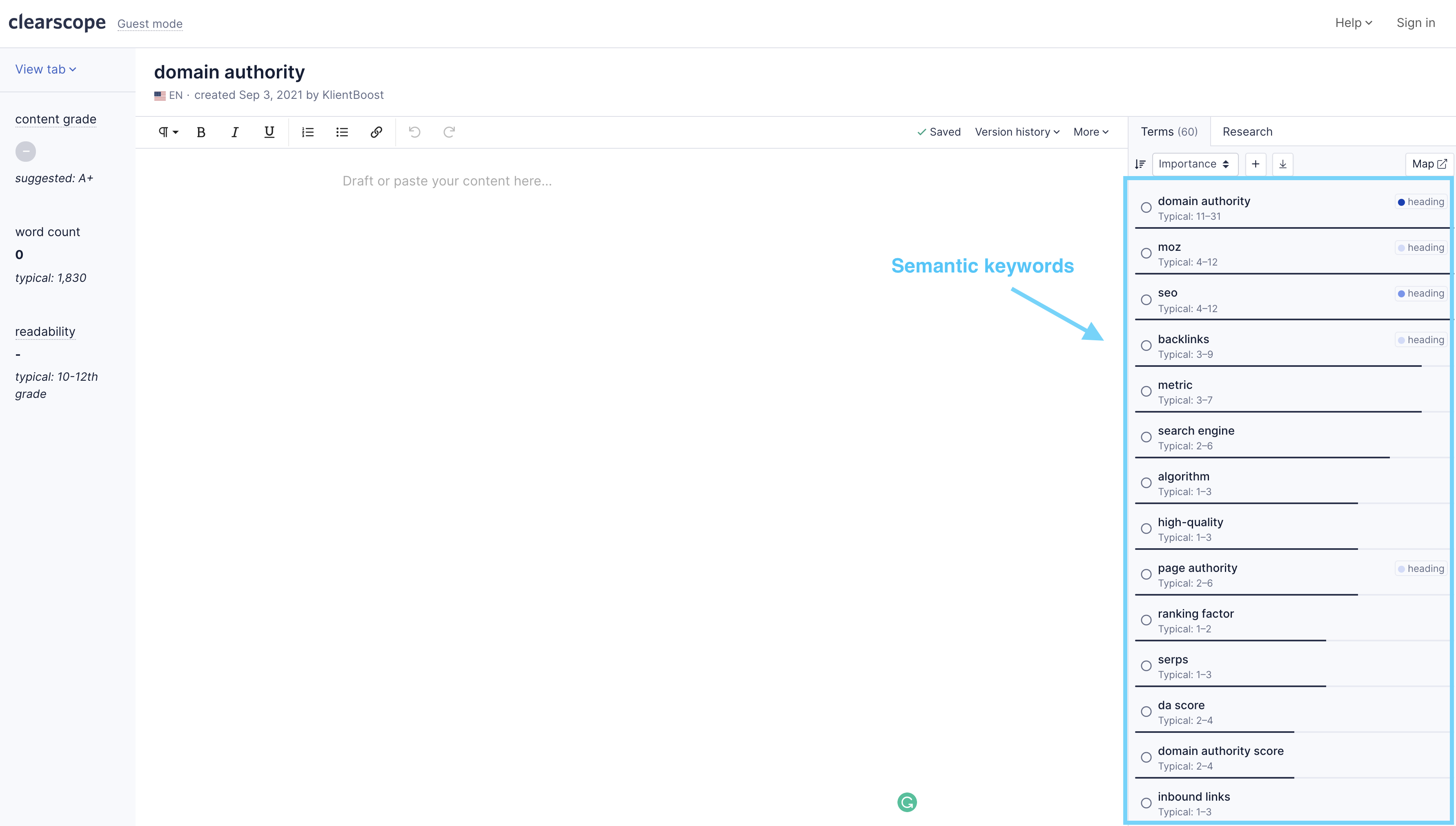
Wrapping up
Good keyword research hinges on good structure.
Without organizing the relationships between an entire family of related keywords, it’s difficult to see the forest for the trees.
This part is so important that we recommend you take the time to put your keywords in a family tree before you start adding data and analysis.
Once you do, keyword research becomes a simple process of working backwards from your least competitive/narrowest keywords to your most competitive/broadest keywords in search of rankable opportunities.
Families need genealogy. So do your keywords.